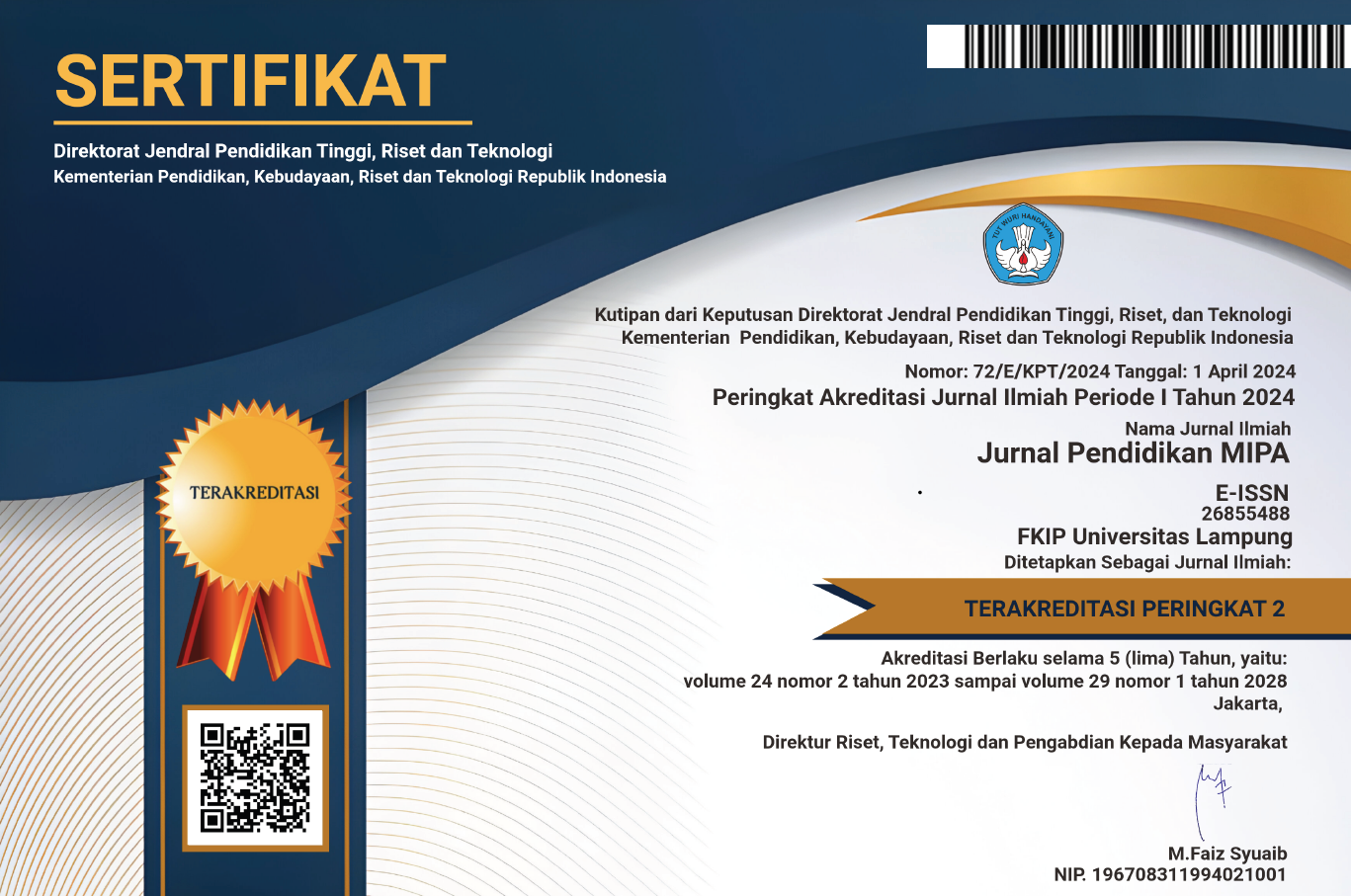Mathematics Teaching Anxiety of Indonesian Elementary School Teachers in Online Learning during COVID-19 Outbreak
 Country:
Country:
(1) Sampoerna Univesity, Indonesia
(2) Sampoerna Univesity, Indonesia
This study aims to identify the scale of mathematics teaching anxiety among Elementary teachers during online learning during the Covid-19 Pandemic at Pekayon district and determine the mathematics anxiety in teaching during the pandemic. The research method that used for this research is a mixed method. The study was conducted on 42 mathematics teachers who teach online learning. Data were collected through a 19-item Mathematics Teaching Anxiety Scale (MTAS) questionnaire. The results indicated that six people (14%) were classified as having high anxiety, twenty-eight people (67%) as having moderate anxiety, and eight people (19%) as having low anxiety. The factors that cause anxiety in teaching mathematics in general are the factors of Student-Directed Mathematics Teaching Anxiety. However, Teachers with high anxiety, teachers with low anxiety, and teachers with normal anxiety differ greatly in preparing materials and learning tools and delivering online learning materials.
Keywords: mathematics teaching anxiety, MTAS, online learning, Covid-19 pandemic
Alkan, V., Coşguner, T., & Fidan, Y. (2019). Mathematics Teaching Anxiety Scale: Construction, Reliability and Validity. International Journal of Assessment Tools in Education, October, 506–520.
Anggianita, S., Yusnira, Y., & Rizal, M. S. (2020). Persepsi Guru terhadap Pembelajaran Daring di Sekolah Dasar Negeri 013 Kumantan. Journal of Education Research, 1(2), 177–182.
Arikunto, S. (2013). Prosedur Penelitian Suatu Pendekatan Praktik. Jakarta: Rineka Cipta.
Ashcraft, M. H., dan Kirk, E. P., 2001, “The Relationship Among Working Memory, Math Anxiety, and Performance”, Journal of Experimental Psychology: General, Vol.130, No.2, 224– 237.
Beilock, S. L., Gunderson, E. A., Ramirez, G., & Levine, S. C. (2010). Female teachers’math anxiety affects girls’math achievement. Proceedings of the National Academy of Sciences of the United States of America, 107, 1860–1863.
Beilock, S.L., Gunderson, E. A., Ramires, G., & Levine, S.C. (2010). Female teachers’ math anxiety affects girls’ math achievement. Proceedings of the National Academy of Science of the United Stated America, 107, 1860-1863.
Braun, V., & Clarke, V. (2006). Using thematic analysis in psychology. Qualitative Research in Psychology, 3(2), 77–101.
Brown, R., & Josephs, R. (1999). A burden of proof: Stereotype relevance and gender differences in math performance. Journal of Personality and Social Psychology, 76(2), 246-257.
Cohen, Louis, et al. (2007). Sixth Edition: Research Methods in Education. London: Routledge
Creswell, J. W., & L., P. C. V. (2011). Designing and conducting mixed methods research. SAGE Publications.
Hakiman, 2020. Pembelajaran daring. Institut Agama Islam Surakarta. Retrieved from https://iainsurakarta.ac.id/pembelajaran-daring.
Hartatik, S., & Fitriyah, F. K. (2017). Identifikasi Kecemasan Matematika Pada Mahasiswa program Studi Pendidikan guru Sekolah Dasar. JBKI (Jurnal Bimbingan Konseling Indonesia), 2(2), 31
Hembree, R. (1990). The nature, effects and relief of mathematics anxiety. Journal for Research in Mathematics Education, 21, 33-46.
Heru, H., Yuliani, R. E., & Nery, R. S. (2020). Kecemasan mengajar matematika mahasiswa calon guru dalam melakukan praktik mengajar. Jurnal Math Educator Nusantara: Wahana Publikasi Karya Tulis Ilmiah Di Bidang Pendidikan Matematika, 6(1), 1– 12.
Jogiyanto. (2008). Teori Portofolio dan Analisis Investasi. Edisi Kelima, BPFE. Yogyakarta.
Kaufmann, R. & Vallade, J. (2020). Exploring connections in the online learning environment: student perceptions of rapport, climate, and loneliness. Interactive Learning Environments.
Lockyer, L., & Dawson, S. (2011). Learning designs and learning analytics. In Proceedings of the 1st international conference on learning analytics and knowledge, 153- 156.
Maazs, J. & Schloglmann, W. (2006). New mathematics education research and practice. Rotterdam: Sense Publishers.
Malinsky, M., Ross, A., Pannells, T., & McJunkin, M. (2006). Math anxiety in preservice elementary school teachers. Education, 127(2), 274–279.
Marbán, J. M., Palacios, A., & Maroto, A. (2020). Enjoyment of teaching mathematics among pre-service teachers. Mathematics Education Research Journal. Miller, L.D. & Mitchell, C.E. (1994). Mathematics anxiety and alternative methods of evaluation. Journal of Instructional Psychology, 21(4), 353
Mizala, A., Martinez, F. & Martinez, S. (2015). Pre-service elementary school teachers’ expectations about student performance: How their beliefs are affected by their mathematics anxiety and student’s gender. Teaching and Teacher. Education, 50, 70-78.
Peker, M. (2009). The use of expanded microteaching for reducing preservice teachers’ teaching anxiety about mathematics. Scientific Research and Essay 4 (9), 872-880.
Peker, M. (2009a). The use of expanded microteaching for reducing preservice teachers’ teaching anxiety about mathematics. Scientific Research and Essay 4 (9), 872-880.
Peker, M. (2009b). Pre-service teachers’ teaching anxiety about mathematics and their learning styles. Eurasia Journal of Mathematics, Science & Technology Education, 5(4), 335-345.
Peker, M., & Ertekin, E. (2011). The relationship between mathematics teaching anxiety and mathematics anxiety. The New Educational Review, 23, 213-226.
Porsch, R. (2017). Mathematik als Plichtfach in der Primarstufenlehrerausbildung. Mathematikangst, Enthusiasmus und Gründe der Schwerpunktwahl angehender Grundschullehrkräfte. Lehrerbildung Auf Dem Prüfstand, 10, 104-124
Rasmitadila, R., Aliyyah, R.R., Rachmadtullah, R., Samsudim, A. (2020). The Perceptions of Primary School Teachers of Online Learning during the COVID-19 Pandemic Period: A Case Study in Indonesia. Journal of Ethnic and Cultural Studies, 7(2), 90.
Ruffins, P. (2007). A real fear. Diverse: Issues in Higher Education, 24(2), 17-19
Sari, M. H. (2014). Developing a mathematics teaching anxiety scale for classroom teachers. Elementary Education Online, 13(4), 1296-1310.
Sitohang, E.Aprida. (2013). Hubungan Kecemasan Belajar Siswa pada Pelajaran Matematika dengan Hasil Belajar Siswa: Studi Kasus di SMA Asisi Jakarta.
Stoehr, K. J. (2017). Mathematics Anxiety: One Size Does Not Fit All. Journal of Teacher Education, 68(1), 69–84.
Tashakkori, A., & Creswell, J. W. (2007). Editorial: Exploring the Nature of Research Questions in Mixed Methods Research. Journal of Mixed Methods Research, 1(3),
Tatar, E., Zengin, Y., Kagizmanli, T.B. (2015). What is the Relationship between Technology and Mathematics Teaching Anxiety? Educational Technology & Society, 18(1), 67-76.
Uusimaki, L., & Nason, R. (2004). Causes Underlying Pre-Service Teachers’ Negative Beliefs and Anxieties About Mathematics. Conference of the International, 369- 376.
Wilson, S. (2010). Pre-service Teachers Constructing Positive Mathematical Identities: Positing a Grounded Theory Approach. 33rd annual conference of the Mathematics Education Research Group of Australasia, 642-648.
Refbacks
- There are currently no refbacks.

This work is licensed under a Creative Commons Attribution-ShareAlike 4.0 International License.






